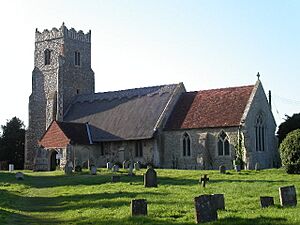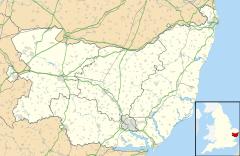Iken facts for kids
Quick facts for kids Iken |
|
|---|---|
 St Botolph's Church, Iken |
|
| Population | 101 (2011) |
| District |
|
| Shire county | |
| Region | |
| Country | England |
| Sovereign state | United Kingdom |
| Post town | Woodbridge |
| Postcode district | IP12 |
| EU Parliament | East of England |
| UK Parliament |
|
Iken is a small village in the county of Suffolk, England. It is located near the mouth of the River Alde, close to the North Sea. The area around Iken used to be open land with heath and sheep pastures. Today, it is next to Tunstall Forest, which was planted by the Forestry Commission.
Iken was once part of a large property called Sudbourne Hall Estate. Most of the village was made up of farms rented by tenants and homes for farm workers. The estate owners cared more about hunting than farming. They even built a special pond for catching ducks in the 1700s. After the estate was divided, Iken remained a small, quiet village. Only a few new houses have been built there over the years.
Before railways were common, Iken Cliff was a busy place for trade. People used it to transport goods like coal and wheat. There was even a pub near the shore. Flat boats would rest on the mud at low tide. Workers would then move goods using wheelbarrows. The last open heathland near Iken Cliff was plowed for farming after World War II.
The village's population was highest in 1840, with about 380 people. Since then, it has slowly gone down to around 100 residents.
During World War II, most of Iken and the nearby village of Sudbourne were used for battle training. This training helped prepare soldiers for the D-Day landings in June 1944. The people living in Iken had to move away. They returned to their homes sometime after the war ended.
The famous composer Benjamin Britten set his opera The Little Sweep in Iken Hall. At that time, it was the home of Margery Spring Rice, who helped start the Aldeburgh Festival. Britten, who lived nearby, tried to keep a walking path open along the River Alde to Iken Church, but he was not successful.
St Botolph's Church
St Botolph's Church is a very old building in Iken. It is thought to be the most likely place for Saint Botolph's Abbey, called Ikenhoe. This was an important religious site long ago. During digs in 1977, parts of a large stone Saxon cross were found. This cross was built into the wall of the church tower. It had carvings of dog and wolf heads. These animals were symbols of St Botolph in the Middle Ages. Because of this, many believe the cross was a memorial to him.
The church is a Grade II listed building. This means it is a historically important building. It is the only listed building in the village. The oldest part of the church is the nave, which dates back to before 1200. The chancel, another part of the church, was rebuilt in 1853. The church tower was built in the 1400s.
In 1968, the church had a terrible fire caused by sparks from a bonfire. It was badly damaged. Today, it is one of 18 churches in the Wilford Benefice Group. Inside the church, you can see a war memorial. It remembers the ten men from the village who died in WWI. There is also an Orthodox icon dedicated to St Botolph. The church also has a 15th-century octagonal font, which is a basin used for baptisms.
A writer and historian named Julian Tennyson is remembered with a headstone in the churchyard. He was known for his writings about Suffolk. He died in battle in Burma in 1945.
The old rectory, which was the home of the church's priest, is next door. It is now called the Anchorage. After World War II, it was sold to a private owner. Because of a mistake in the sale papers, access to the church became very difficult for a while.
Village Governance
Iken has a parish council. This is a local group that helps manage village matters.
Iken gained national attention after the church fire. A famous judge, Sir Robert Megarry, held a court hearing in Iken itself. He did this partly to hear from a witness who could not travel to London. He also held a mock funeral to test a disputed right of way. The result of this legal case meant that materials for rebuilding the church had to be carried in on foot.
Village Buildings
Iken once had two pubs: the Anchor and the Boot. Both of these pubs closed in the 1800s.
There was also a poorhouse in the village by the early 1800s. A poet named George Crabbe used to help poorer patients in Iken when he worked as a surgeon. His poem "The Workhouse" might have been based on his experiences in Iken, as well as in Aldeburgh. The old workhouse building was bought by the Sudbourne Hall Estate in 1896.
See also
 In Spanish: Iken para niños
In Spanish: Iken para niños


